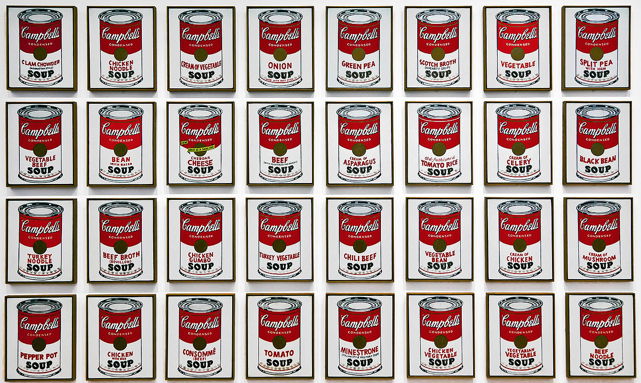Andy Warhol
Andy Warhol was a leading figure in the Pop Art movement. Like his contemporaries Roy Lichtenstein and Robert Rauschenberg, Warhol wryly responded to the mass media of the 1960s. His silkscreen-printed paintings of cultural and consumer icons, featuring Marilyn Monroe and Elizabeth Taylor, as well as Campbell’s Soup cans and Brillo boxes, would make him one of the most famous artists of his generation. “The best thing about a picture is that it never changes, even when the people in it do,” he once explained. Warhol was a gay man, keeping much of his private life a secret, he sometimes referenced his sexuality through art. In 1964, Warhol rented a studio loft on East 47th street in midtown Manhattan which was later known as the Factory. Quick to realize the cult of celebrity, the Factory acted as a hub for fashionable movie stars, models, and artists who became fodder for his prints and films, as well as a performance venue for The Velvet Underground. The prolific artist worked across painting, sculpture, and new media throughout the 1960s and 1970s.

Roy Litchtenstein
Roy Lichtenstein was one of the most influential and innovative artists of the second half of the twentieth century. He is preeminently identified with Pop Art, a movement he helped originate, and his first fully achieved paintings were based on imagery from comic strips and advertisements and rendered in a style mimicking the crude printing processes of newspaper reproduction. These paintings reinvigorated the American art scene and altered the history of modern art. As with his most celebrated Pop paintings of the 1960s, Lichtenstein gravitated toward what he would characterize as the “dumbest” or “worst” visual item he could find and then went on to alter or improve it. In the 1960s, commercial art was considered beneath contempt by the art world; in the early 1950s, with the rise of Abstract Expressionism, nineteenth-century American narrative and genre paintings were at the nadir of their reputation among critics and collectors. Paraphrasing, particularly the paraphrasing of despised images, became a paramount feature of Lichtenstein’s art.

James Rosenquist
A seminal figure in the Pop art movement, James Rosenquist is best known for his colossal collage paintings of enigmatically juxtaposed fragmentary images borrowed largely from advertisements and mass media. Brought together and enlarged so as to cover entire gallery walls and overwhelm the viewer, these seemingly unrelated pictures of consumer products, weaponry, and celebrities hint at the artist's social, political, and cultural concerns. The billboard painter-turned-artist's early works are also considered emblematic of a burgeoning consumer culture in America during the 1960s. Six decades into his career, Rosenquist continues to create massive, provocative paintings, whose relevance hinges on their engagement with current economic, political, environmental, and scientific issues. James Rosenquist's irreverent and at times surreal appropriation of popular culture and the materials and techniques of advertising inspired several other artists.



